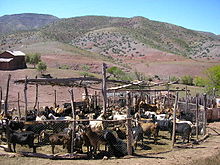
Back رعي جائر Arabic Sobrepastura Catalan Überweidung German Tropaŝtado Esperanto Sobrepastoreo Spanish Gainlarratze Basque چرای بیرویه Persian Ylilaiduntaminen Finnish Surpâturage French רעיית יתר HE




Overgrazing occurs when plants are exposed to intensive grazing for extended periods of time, or without sufficient recovery periods.[1] It can be caused by either livestock in poorly managed agricultural applications, game reserves, or nature reserves. It can also be caused by immobile, travel restricted populations of native or non-native wild animals.
Overgrazing reduces the usefulness, productivity and biodiversity of the land and is one cause of desertification and erosion. Overgrazing is also seen as a cause of the spread of invasive species of non-native plants and of weeds. Degrading land, emissions from animal agriculture and reducing the biomass in a ecosystem contribute directly to climate change[2] between grazing events. Successful planned grazing strategies have been in support of the American bison of the Great Plains,[3][4] or migratory wildebeest of the African savannas,[5] or by holistic planned grazing.[6]
- ^ Mysterud, Atle (2006). "The concept of overgrazing and its role in management of large herbivores". Wildlife Biology. 12 (2): 129–141. doi:10.2981/0909-6396(2006)12[129:TCOOAI]2.0.CO;2. ISSN 0909-6396. S2CID 55599448.
- ^ "The relationship between overgrazing and the US environment". ArcGIS StoryMaps. 13 March 2020. Retrieved 2021-03-20.
- ^ Laduke, Winona (1999). All Our Relations: Native Struggles for Land and Life. Cambridge, MA: South End Press. p. 146. ISBN 0896085996. Retrieved 30 March 2015.
- ^ Duval, Clay. "Bison Conservation: Saving an Ecologically and Culturally Keystone Species" (PDF). Duke University. Archived from the original (PDF) on March 8, 2012. Retrieved April 13, 2015.
- ^ In balance with, and accompanied by, prides of keystone predators.
- ^ "Holistic Land Management: Key to Global Stability" by Terry Waghorn. Forbes. 20 December 2012.